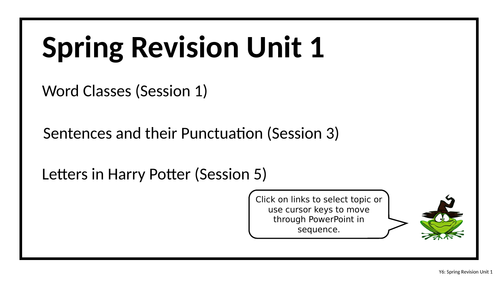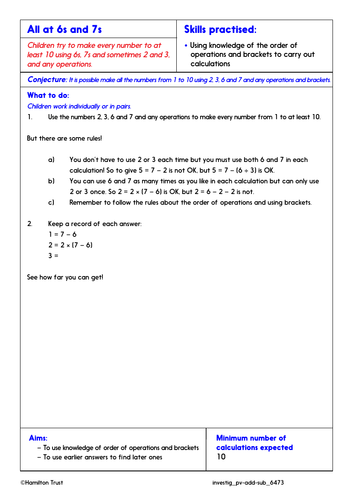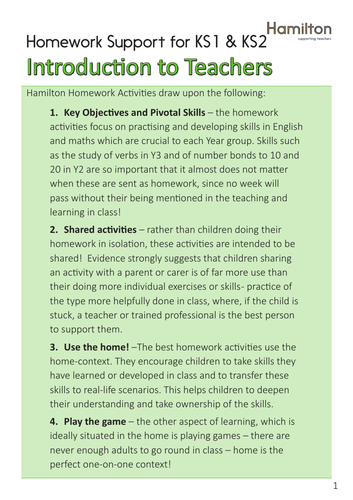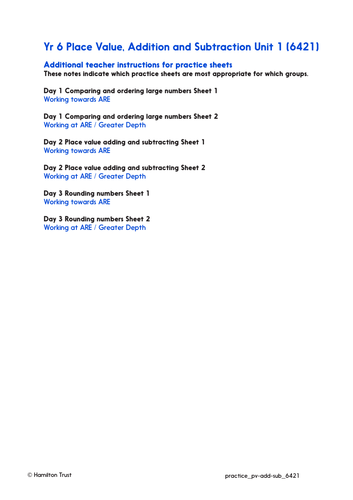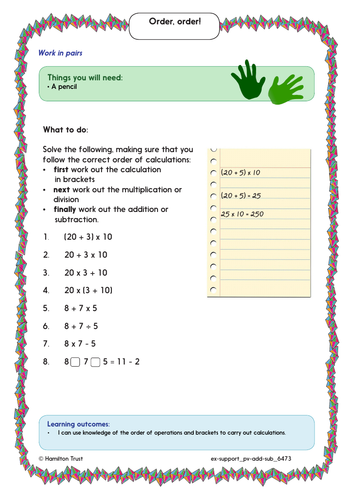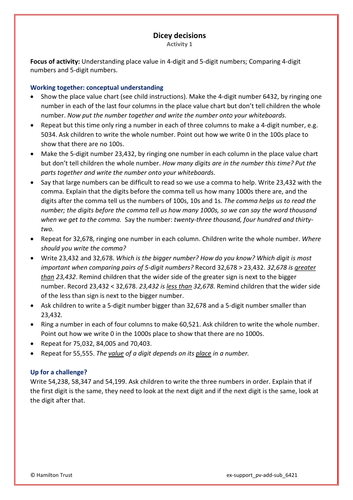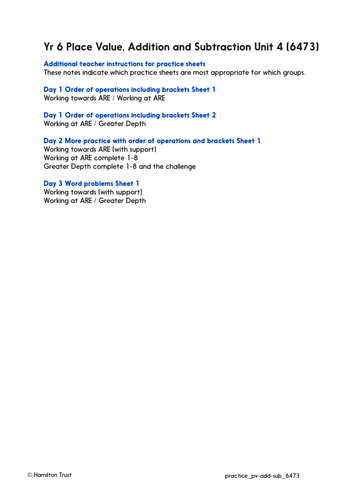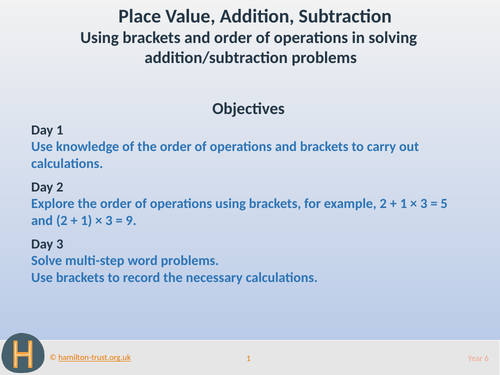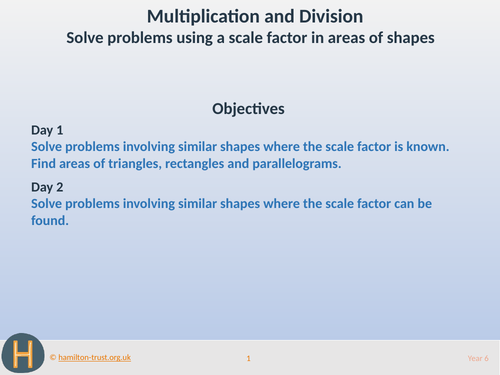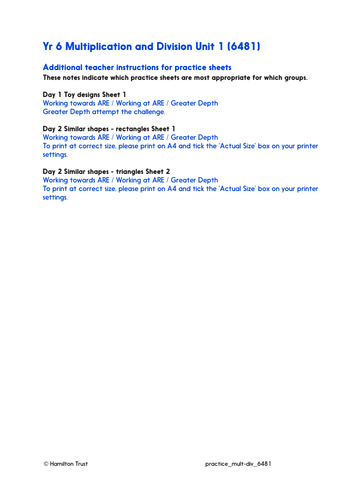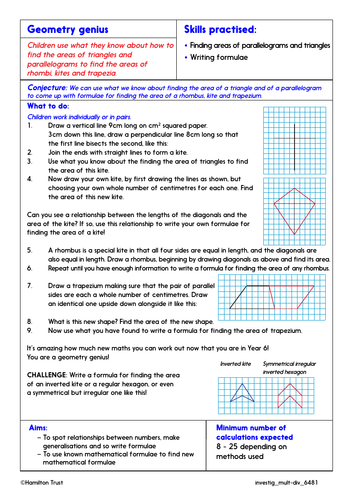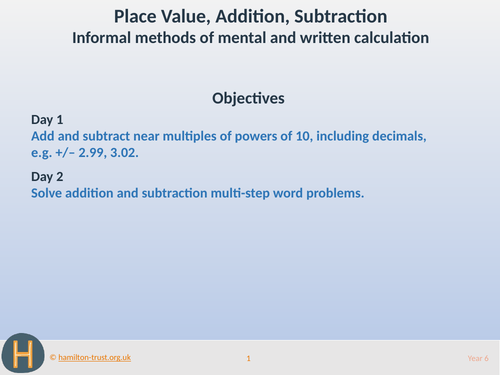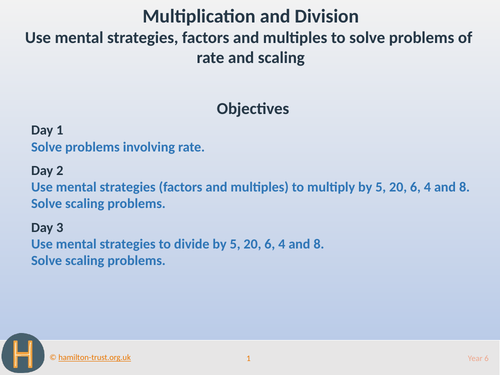
3k+Uploads
9974k+Views
11588k+Downloads

Use brackets and order of operations - Problem-Solving Investigation - Year 6
This in-depth maths investigation is an open-ended problem solving activity for Year 6 children. It can be used to support teaching towards the objective: using brackets and order of operations in solving addition/subtraction problems.
In-depth Investigation: All at 6s and 7s
Children try to make every number to at least 10 using 6, 7 and sometimes 2 and 3, and any operations.
This investigation will develop maths meta-skills, support open-ended questioning and logical reasoning, and enable children to learn to think mathematically and articulate mathematical ideas.
This problem-solving investigation is part of our Year 6 Place Value, Addition and Subtraction block. Each Hamilton maths block contains a complete set of planning and resources to teach a term’s worth of objectives for one of the National Curriculum for England’s maths areas.

Homework Support - Upper Key Stage 2
Supporting documents for making the most of Hamilton homework. Includes:
Homework support
Guidance for teachers in using homework effectively.
Homework leaflets for parents - Upper Key Stage 2
An attractive printable leaflet for parents.
Letter to parents
An adaptable letter to parents, explaining how they can help their child get the most out of homework.
You can find our homework bundles listed below. Each bundle includes around 12 activities, and should be enough to cover a term - that is one a week taking into account festivals and school trips and allowing a little flexibility!
Hamilton provides high quality, fully adaptable English, maths, science and cross-curricular topic planning and resources for primary school teachers to use in their classrooms. Find everything you need to teach pedagogically robust and engaging lessons. Visit Hamilton Trust.

Add, subtract & round 6-/7-digit numbers - Practice Worksheets & Answers - Year 6
Year 6 Place Value, Addition and Subtraction: Use place value to add, subtract and round 6- and 7-digit numbers.
Procedural fluency practice worksheets to achieve maths mastery. Differentiated for children working towards Age Related Expectations (ARE), at ARE and at greater depth. Includes answers.
Day 1 - Comparing and ordering numbers including use of > and <.
Day 2 - Use place value to add and subtract from large numbers.
Day 3 - Rounding numbers to the nearest 1,000,000, 100,000 and 10,000.
These procedural fluency practice sheets are part of our Year 6 Place Value, Addition and Subtraction block. Each Hamilton maths block contains a complete set of planning and resources to teach a term’s worth of objectives for one of the National Curriculum for England’s maths areas.

Understand/calculate negative numbers - Practice Worksheets & Answers- Year 6
Year 6 Place Value, Addition and Subtraction: Understand negative numbers; perform calculations across 0.
Procedural fluency practice worksheets to achieve maths mastery. Differentiated for children working towards Age Related Expectations (ARE), at ARE and at greater depth. Includes answers.
Day 1 - Calculating rise and fall in temperatures.
Day 2 - Adding and subtracting with negative numbers.
Solving problems with negative numbers.
These procedural fluency practice sheets are part of our Year 6 Place Value, Addition and Subtraction block. Each Hamilton maths block contains a complete set of planning and resources to teach a term’s worth of objectives for one of the National Curriculum for England’s maths areas.

Use brackets and order of operations - Extra Support Activity - Year 6
This activity is designed to be used by a teacher or a TA with children who need extra support before they can tackle these objectives: Using brackets and order of operations in solving addition/subtraction problems.
Order, Order!
Practising ordering calculations involving brackets, +, −, × and ÷
This Extra Support Activity is part of our Year 6 Place Value, Addition and Subtraction block. Each Hamilton maths block contains a complete set of planning and resources to teach a term’s worth of objectives for one of the National Curriculum for England’s maths areas.

Add, subtract & round 6-/7-digit numbers - Extra Support Activity - Year 6
These activities are designed to be used by a teacher or a TA with children who need extra support before they can tackle this objective: Use place value to add, subtract and round 6- and 7-digit numbers.
Dicey Decisions
Understanding place value in 4-digit and 5-digit numbers. Comparing 4-digit numbers and 5-digit numbers.
Zoom Zoom
Rounding 5-digit numbers to the nearest 100, 1000 and 10,000.
This Extra Support Activity is part of our Year 6 Place Value, Addition and Subtraction block. Each Hamilton maths block contains a complete set of planning and resources to teach a term’s worth of objectives for one of the National Curriculum for England’s maths areas.

Use brackets and order of operations - Practice Worksheets & Answers - Year 6
Year 6 Place Value, Addition and Subtraction: Use brackets and order of operations.
Procedural fluency practice worksheets to achieve maths mastery. Differentiated for children working towards Age Related Expectations (ARE), at ARE and at greater depth. Includes answers.
Day 1 - Order of brackets and operations activity sheets.
Day 2 - Identifying where brackets go in number sentences.
Day 3 - Solving multi-step word problems with brackets.
These procedural fluency practice sheets are part of our Year 6 Place Value, Addition and Subtraction block. Each Hamilton maths block contains a complete set of planning and resources to teach a term’s worth of objectives for one of the National Curriculum for England’s maths areas.

Strategies in mental & written calculation - Extra Support Activity - Year 6
This activity is designed to be used by a teacher or a TA with children who need extra support before they can tackle this objective: Informal methods of mental and written calculation.
Dream Shopping
Finding change from £100 using Frog (counting up)
This Extra Support Activity is part of our Year 6 Place Value, Addition and Subtraction block. Each Hamilton maths block contains a complete set of planning and resources to teach a term’s worth of objectives for one of the National Curriculum for England’s maths areas.

Use brackets and order of operations - Teaching Presentation - Year 6
This presentation provides three days of teaching that cover the objective:
Using brackets and order of operations in solving addition/subtraction problems
It includes starter activities, whole class teaching, group activities, practice sheets and mastery questions. It can be used on a variety of interactive whiteboards.
Day 1 Teaching
Write 4 + 3 × 12. Ask half class to work from left to right and others work from right to left. Discuss different answers. Introduce the rules: Brackets, then multiplication/division, then addition/subtraction. Reiterate with 4 + 16 ÷ 2 and (4 + 16) ÷ 2.
Write on the board: 1. Brackets; 2. Multiplication/division; 3. Addition/subtraction.
Day 2 Teaching
Explore the order of operations using brackets, for example, 2 + 1 × 3 = 5 and (2 + 1) × 3 = 9. Discuss how putting the brackets in different places can alter the answer to a calculation. Write on the board 12 + 8 ÷ 4 – 2. Putting brackets in different places, how many different answers can you find?
Day 3 Teaching
Write on the board 78 × 100 – 42 and 78 × (100 – 42). Remind the class that we find the answers to calculations in brackets first. Discuss why the answer to the second calculation is different. Display two word problems (see teaching download); use knowledge of the order of operations to solve.
This teaching is part of Hamilton’s Year 6 Place Value, Addition and Subtraction block. Each Hamilton maths block contains a complete set of planning and resources to teach a term’s worth of objectives for one of the National Curriculum for England’s maths areas.

Understand/calculate negative numbers - Teaching Presentation - Year 6
This presentation provides two days of teaching that cover the objectives:
Understand negative numbers
Perform calculations across 0
It includes starter activities, whole class teaching, group activities, practice sheets and mastery questions. It can be used on a variety of interactive whiteboards.
Day 1 Teaching
Use negative numbers in the context of temperature. Launch ITP Thermometer, choose a range of −10 to 10. At what temperature might we get ice outside? Why? Agree that as water freezes at 0 degrees Celsius the temperature will be less than this, e.g. –1, –2, etc. Ask children to label some temperatures and calculate rises/falls in temperature.
Day 2 Teaching
Show a line from –20 to 20, with multiples of 5 labelled. This has positive/negative numbers. Numbers can be less than 0 (temperatures, a bank account overdrawn, or a depth below sea level).
Make up additions and subtractions with positive and negative answers: What do you think 5 subtract 6 is?
This teaching is part of Hamilton’s Year 6 Place Value, Addition and Subtraction block. Each Hamilton maths block contains a complete set of planning and resources to teach a term’s worth of objectives for one of the National Curriculum for England’s maths areas.

Add, subtract & round 6-/7-digit numbers - Teaching Presentation - Year 6
This presentation provides three days of teaching that cover the objective:
Use place value to add, subtract and round 6- and 7-digit numbers
It includes starter activities, whole class teaching, group activities, practice sheets and mastery questions. It can be used on a variety of interactive whiteboards.
Day 1 Teaching
Write on the board 4,351,468. Discuss the commas or spaces used to separate parts. Cover the first four digits. Read the number. Uncover the next three digits and read it. Uncover the final digit and read again. Repeat with other 7-digit numbers. Practise some ‘place value’ calculations, e.g. 2,743,561 – 40,000? Now subtract 500. Subtract 700,000. Subtract 3001. What’s left?
Write on the board ☐,☐☐☐,☐☐☐ > ☐,☐☐☐,☐☐☐. Roll a 0–9 dice and ask children where to place the digit. Explain that they are to try to make the first number greater than the second number. Repeat until all the spaces are filled.
Day 2 Teaching
Use the IWB calculator’s constant function to repeatedly add then subtract 1, 10, 100, 1000, 10,000, 100,000 and 1,000,000 to/from 5,555,555. Take care when crossing boundaries of powers of ten.
Day 3 Teaching
Children mark halfway on a sketched 1,000,000 to 2,000,000 number line. Ask them to mark a number rounding to 1,000,000 and one rounding to 2,000,000.
Repeat for rounding to the nearest 100,000 between 2,500,000 and 2,600,000.
Repeat for rounding to the nearest 10,000 between 2,530,000 and 2,540,000.
This teaching is part of Hamilton’s Year 6 Place Value, Addition and Subtraction block. Each Hamilton maths block contains a complete set of planning and resources to teach a term’s worth of objectives for one of the National Curriculum for England’s maths areas.
Bundle

Use brackets and order of operations (Year 6 PV, Addition and Subtraction)
This bundle provides three days of teaching that cover the objective:
Using brackets and order of operations in solving addition/subtraction problems
Teaching Presentation
The teaching presentation includes starter activities, whole class teaching, group activities, practice sheets and mastery questions. It can be used on a variety of interactive whiteboards.
Practice Worksheets
The procedural fluency practice worksheets are differentiated for children working towards Age Related Expectations (ARE), at ARE and at greater depth.
Problem-Solving Investigation
This in-depth maths investigation will develop maths meta-skills, and enable children to learn to think mathematically and articulate mathematical ideas.
Extra Support
The extra support activity is designed to be used by a teacher or a TA with children who need extra support.
This teaching is part of Hamilton’s Year 6 Place Value, Addition and Subtraction block. Each Hamilton maths block contains a complete set of planning and resources to teach a term’s worth of objectives for one of the National Curriculum for England’s maths areas.

Scale factor problems concerning area - Teaching Presentation - Year 6
This presentation provides two days of teaching that covers the objective:
Solve problems using a scale factor in areas of shapes
It includes starter activities, whole class teaching, group activities, practice sheets and mastery questions. It can be used on a variety of interactive whiteboards.
Day 1 Teaching
Children sketch a right-angle triangle where the sides along the right angle are 4cm and 7cm long. They measure the longest side, compare, and find the area. Draw a similar triangle with each side next to the right angle twice the length. Compare the longest sides. Define similar triangles and model the scaling effect. Remind children how to find the area of a parallelogram (see below plan), multiplying the base by the height.
Group Activities
Day 2 Teaching
Define similar shapes as identical in shape, but not in size. Show ‘Similar shapes’ (see resources). Ask children to find 2 rectangles which look similar. Measure the sides of each. Ask children to work out the scale factor (1½). Repeat for triangles (scale factor is 3).
This teaching is part of Hamilton’s Year 6 Multiplication and Division block. Each Hamilton maths block contains a complete set of planning and resources to teach a term’s worth of objectives for one of the National Curriculum for England’s maths areas.
Bundle

Strategies in mental & written calculation (Year 6 PV, Addition and Subtraction)
This bundle provides two days of teaching that cover the objectives:
Informal methods of mental and written calculation
Teaching Presentation
The teaching presentation includes starter activities, whole class teaching, group activities, practice sheets and mastery questions. It can be used on a variety of interactive whiteboards.
Practice Worksheets
The procedural fluency practice worksheets are differentiated for children working towards Age Related Expectations (ARE), at ARE and at greater depth.
Extra Support
The extra support activity is designed to be used by a teacher or a TA with children who need extra support.
This teaching is part of Hamilton’s Year 6 Place Value, Addition and Subtraction block. Each Hamilton maths block contains a complete set of planning and resources to teach a term’s worth of objectives for one of the National Curriculum for England’s maths areas.

Scale factor problems concerning area - Practice Worksheets & Answers - Year 6
Year 6 Multiplication and Division: Solve problems using a scale factor in areas of shapes.
Procedural fluency practice worksheets to achieve maths mastery. Differentiated for children working towards Age Related Expectations (ARE), at ARE and at greater depth. Includes answers.
Day 1 - Calculate the dimensions of toys, given scale factors.
Day 2 - Identify pairs of similar rectangles and triangles. Use a scale factor to calculate the lengths of sides.
These procedural fluency practice sheets are part of our Year 6 Multiplication and Division block. Each Hamilton maths block contains a complete set of planning and resources to teach a term’s worth of objectives for one of the National Curriculum for England’s maths areas.

Scale factor problems concerning area - Problem-Solving Investigation - Year 6
This in-depth maths investigation is an open-ended problem solving activity for Year 6 children. It can be used to support teaching towards the multiplication and division objective: solve problems using a scale factor in areas of shapes.
In-depth Investigation: Geometry Genius
Children use what they know about how to find the areas of triangles and parallelograms to find the areas of rhombi, kites and trapezia.
This investigation will develop maths meta-skills, support open-ended questioning and logical reasoning, and enable children to learn to think mathematically and articulate mathematical ideas.
This problem-solving investigation is part of our Year 6 Multiplication and Division block. Each Hamilton maths block contains a complete set of planning and resources to teach a term’s worth of objectives for one of the National Curriculum for England’s maths areas.

Solve rate and scaling problems - Practice Worksheets & Answers - Year 6
Year 6 Multiplication and Division: Use mental strategies, factors and multiples to solve problems of rate and scaling.
Procedural fluency practice worksheets to achieve maths mastery. Differentiated for children working towards Age Related Expectations (ARE), at ARE and at greater depth. Includes answers.
Day 1 - Answer problems about growth rates for blue whale calves and humans.
Day 2 - Work out actual dinosaur sizes, given model dimensions.
Day 3 - Work out the dimensions of dinosaur toys, given full size measurements.
These procedural fluency practice sheets are part of our Year 6 Multiplication and Division block. Each Hamilton maths block contains a complete set of planning and resources to teach a term’s worth of objectives for one of the National Curriculum for England’s maths areas.
Bundle

Understand/calculate negative numbers (Year 6 PV, Addition and Subtraction)
This bundle provides two days of teaching that cover the objectives:
Understand negative numbers
Perform calculations across 0
Teaching Presentation
The teaching presentation includes starter activities, whole class teaching, group activities, practice sheets and mastery questions. It can be used on a variety of interactive whiteboards.
Practice Worksheets
The procedural fluency practice worksheets are differentiated for children working towards Age Related Expectations (ARE), at ARE and at greater depth.
Problem-Solving Investigation
This in-depth maths investigation will develop maths meta-skills, and enable children to learn to think mathematically and articulate mathematical ideas.
This teaching is part of Hamilton’s Year 6 Place Value, Addition and Subtraction block. Each Hamilton maths block contains a complete set of planning and resources to teach a term’s worth of objectives for one of the National Curriculum for England’s maths areas.

Strategies in mental & written calculation - Teaching Presentation - Year 6
This presentation provides two days of teaching that cover the objective:
Informal methods of mental and written calculation
It includes starter activities, whole class teaching, group activities, practice sheets and mastery questions. It can be used on a variety of interactive whiteboards.
Day 1 Teaching
Demonstrate how to use ‘add and adjust’ strategies to add ‘nearly numbers’, such as 4735 + 203, 4735 + 197, 4735 + 1995, 465 + 299, 4.65 + 2.99.
Repeat to ‘subtract and adjust’ for subtraction of nearly numbers, e.g. 4735 – 705, 4735 – 197, 4735 – 1995, 6.25 – 1.98, 4.21 – 3.02.
Day 2 Teaching
Show costs of activities. Ask children to estimate the total cost (e.g. rounding to the nearest pound). Model using column addition to find the exact cost, and then Frog to find the change from the £100 budget. Sketch a bar model to represent this.
This teaching is part of Hamilton’s Year 6 Place Value, Addition and Subtraction block. Each Hamilton maths block contains a complete set of planning and resources to teach a term’s worth of objectives for one of the National Curriculum for England’s maths areas.

Solve rate and scaling problems - Teaching Presentation - Year 6
This presentation provides three days of teaching that covers the objective:
Use mental strategies, factors and multiples to solve problems of rate and scaling
It includes starter activities, whole class teaching, group activities, practice sheets and mastery questions. It can be used on a variety of interactive whiteboards.
Day 1 Teaching
A blue whale is typically 24–30m in length, 4 times as long as the class. It has the fastest growth rate: calves grow 90kg/day, 2.5cm in length per day. So how much in a week? Explain that these are rates: It eats 3 tonnes per day. It grows 90Kg per day. The rate is weight (kg/tonnes) per day (time).
Day 2 Teaching
Recap mental strategies to multiply by 5, by 20, by 6, by 8. Show a table of dimensions of scale models of dinosaurs. Each model is 1/20 of the actual height and length. Ask how we work out full size, drawing out multiplying by 20.
Day 3 Teaching
Recap mental strategies to divide by 5, by 20, by 6, by 8. Say that a toy shop is selling dinosaurs where each measurement is 1/200 of the size of the real dinosaurs. Ask children in pairs to find 1/200 of the actual measurements.
This teaching is part of Hamilton’s Year 6 Multiplication and Division block. Each Hamilton maths block contains a complete set of planning and resources to teach a term’s worth of objectives for one of the National Curriculum for England’s maths areas.

